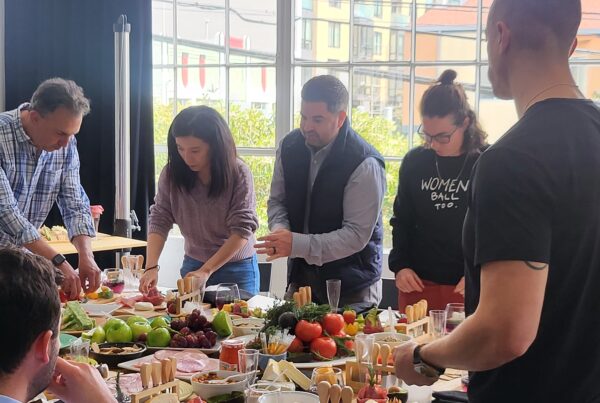There are many vague definitions out there for the word ‘team’. It’s generally described as a group of people who join forces to achieve a common goal.
But there is far more to it than this simple explanation. Teamwork has existed as long as there has been life on Earth.
It is seen throughout the natural world, where animals rely on their pack, herd, swarm or (insert relevant collective noun here) to survive and thrive.
History is filled with sterling examples of teamwork. If we consider what the Romans accomplished — not just in terms of expansion, but architecture and innovation — the one constant was that no one worked alone.
New evidence shows that the Pyramids were built by tens of thousands of skilled workers over many lifetimes. The Apollo 11 mission had approximately 400,000 people working behind the scenes to make the moon landing possible.
Humans understand the need for teamwork, but the challenge comes when taking individuals with vastly different backgrounds, work ethics, value systems, and ideas to collaborate productively. And that’s how team building came to be.
The History of Team Building
Although humans have always collaborated to achieve common goals, the psychology of the concept only gained traction in the 1920s. Initially, the public relations industry used relevant psychology to adapt customer emotions and thought processes, hoping to increase sales.
However, they then decided to take it internally, apply it to the workforce and see if it boosted productivity. It did.
This is attributed to facilitating a sense of group identity and the fostering of support and unity. Critical elements were identified for building team dynamics. They include:
- Workers need to see that those in management take a personal interest in them and their achievements.
- Those in leadership positions need to take pride in the group project and outcomes.
- The team needs to have a say in their work conditions and know they are being heard.
- Constant feedback is essential.
- The group needs to take pride in their work and outcomes.
Since then, the concept of team building has springboarded from these essential elements, and much research has delved into the idea.
Industrial psychology boomed in the 90s, and since then, team-building strategies have become the norm in the workplace, evolving as people’s needs and ideas change with the times.
Modern Team Building Training
The benefits of team building are endless, but the three most important are that it encourages communication, develops a united company culture, and increases productivity.
There are many reasons for this. The most important thing is the building of trust and unity between employees.
This leads to deeper engagement and the freedom to express opinions, needs, and concerns. When people work together, they are more motivated to succeed, knowing that they are a part of the bigger picture.
People who trust each other will step in and support when they need to and will lean on each other’s strengths.
A Lesson from Geese

The next time you look up and see a flock of geese flying in a V formation, consider the incredible example of teamwork in action.
As each goose flaps its wings, it produces a lift that assists the bird behind it. This support allows them to fly further for longer.
But surely this puts all the pressure on the guy at the front, flapping away with no goose in front of him to give him some lift? Well, they have it all figured out.
Leading in shifts, the lead goose will fall out and join the back, with another goose taking the lead.
The load is shared evenly, ensuring that no goose reaches burnout. Another interesting thing is that the racket you hear as they fly overhead is literally geese cheering and encouraging each other. It makes you reconsider the term “birdbrain,” doesn’t it?
How Team Building Training Works
Team-building training usually serves the bigger picture and a more specific goal. It can build relationships, celebrate accomplishments, and open communication channels. But it can also serve as a think tank when a particular problem needs solving.
It’s essential to have your purpose in mind to ensure maximum success. Consider what outcomes you are seeking, who the participants are, and how much time you need, and brainstorm activities that will make employees energized and eager to participate in Team Building Events
Whether you choose to hold your team-building activities on your premises or book an off-site venue, facilitating positive engagement is essential.
The best team-building activities create bonds and connections while teaching new skills. And the best way to do this is through good, old-fashioned fun.
Having fun together is always a bonding experience. When you have fun, your brain pumps you full of feel-good hormones, and you make associations between the experience (including who was with you) and those feelings.
Build Team Building Events activities into your company culture so that you get the dripping tap effect, fostering relationships continuously.
People also connect better when not wearing their ‘work hat’. They see each other in a different light, recognizing their individuality and shared humanity.
All The Many Benefits
Networking and getting to know each other
This increases morale and adaptability. The fun element also lets your staff know that you value them, and it is seen as a sign of appreciation. Human beings thrive on praise.
Boosting team performance
Projects that involve teamwork will show significant improvement. After learning more about each other during team building activities, employees understand each other better and incorporate each other’s strengths while being mindful and considerate of each other’s weaknesses.
Healthy competition
Many people are competitive by nature, and when it is harnessed in a fun, playful way, you can quickly identify who is motivated by it, even more so when a prize or bragging rights are an incentive.
Team spirit and celebration
Teams who celebrate success and experience the euphoria and camaraderie are motivated to level up and improve so that they have more to celebrate.
Fostering creativity and collaboration
When people brainstorm and problem-solve together, their combined imagination is unstoppable. They spark new ideas and chains of thought in each other and can throw out the pros and cons of various suggestions, leaving no stone unturned.
Communication
It’s a no-brainer. When people communicate well, they are more confident, comfortable, and authentic.
Building interdepartmental bridges
Most departments have ample informal opportunities to get to know each other, figure out a dynamic and forge a team approach.
However, a company comprises multiple departments that rely on each other. Team Building Events allow the opportunity to connect the departments and encourage collaboration across the organization.
Recognizing leadership potential in oneself and others
Many people have leadership qualities that they are not even aware of until they have an opportunity to bring them out. Employers can learn a lot from their upcoming employees, and employees can recognize the valuable skills their peers can offer the team.
Online Team Building in the Wake of COVID- 19

The Team Building Events dynamic has shifted significantly over the past two years. Gone are the days of traditional office parties and conferences, with employers always having the challenge of social distancing in the back of their minds.
Fortunately, innovative and creative minds have thought outside of the box and found ways to have fun, engaging team-building activities remotely.
Virtual team building is gaining momentum, and there are many options available, depending on your team’s size, needs, and interests.
Rockoly offers fun, interactive online cooking classes and workshops. Using live streaming and video conferencing, a professional chef will facilitate the team-building experience and guide teams to prepare various enticing, delicious meals.
Rockoly also offers a variety of workshops that encourage connection, and socialization and boost morale.
It’s everything you need for successful team-building training in a remote world! Get started here.








